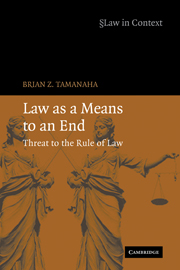Book contents
- Frontmatter
- Contents
- Acknowledgments
- Introduction
- Part 1 The spread of legal instrumentalism
- 1 Non-instrumental views of law
- 2 A changing society and common law in the nineteenth century
- 3 Nineteenth-century legislation and legal profession
- 4 Instrumentalism of the legal realists
- 5 Twentieth-century Supreme Court instrumentalism
- Part 2 Contemporary legal instrumentalism
- Part 3 Corroding the rule of law
- Epilogue
- Index
- Titles in the series
5 - Twentieth-century Supreme Court instrumentalism
Published online by Cambridge University Press: 25 July 2009
- Frontmatter
- Contents
- Acknowledgments
- Introduction
- Part 1 The spread of legal instrumentalism
- 1 Non-instrumental views of law
- 2 A changing society and common law in the nineteenth century
- 3 Nineteenth-century legislation and legal profession
- 4 Instrumentalism of the legal realists
- 5 Twentieth-century Supreme Court instrumentalism
- Part 2 Contemporary legal instrumentalism
- Part 3 Corroding the rule of law
- Epilogue
- Index
- Titles in the series
Summary
A 1909 article on the courts by political scientist W. F. Dodd observed that “In this field [public policy] decisions of the courts necessarily depend not upon any fixed rules of law but upon the individual opinions of the judges on political and economic questions; and such decisions, resting, as they must, upon no general principles, will be especially subject to reversal or modification when changes take place in the personnel of the courts.” Dodd presciently encapsulated what became the standout theme surrounding the twentieth-century Supreme Court. This chapter conveys how judging and judges on the Supreme Court in several different ways came to be perceived in instrumental terms. The events covered are the 1937 Court Packing Plan and its aftermath, the reforms brought by the Warren Court, and the backlash against those reforms as they played out in connection with later Supreme Courts, leading up to the present.
Court packing plan
President Franklin D. Roosevelt's failed 1937 “court packing plan” has been characterized as a “great constitutional war,” which culminated in a “constitutional revolution.” It was the closest the country had come to a genuine constitutional crisis since the Civil War and Reconstruction.
Roosevelt's New Deal legislative program was an attempt to find solutions to the ongoing economic crisis and to ameliorate the most desperate social and economic consequences that continued to linger from the recent Depression.
- Type
- Chapter
- Information
- Law as a Means to an EndThreat to the Rule of Law, pp. 77 - 98Publisher: Cambridge University PressPrint publication year: 2006

